Phân tích hệ thống chuyển tác, thức và cấu trúc đề - Thuyết của văn bản “A grandmother with muscles” dựa vào lý thuyết ngữ pháp chức năng hệ thống của mark haliday
Khi mọi người nói hoặc viết, họ tạo ra văn bản. Đối với một nhà ngữ
pháp, văn bản là một hiện tượng phong phú, nhiều mặt, có nghĩa theo
nhiều cách khác nhau. Ngữ pháp chức năng hệ thống (SFG) là một loại
ngữ pháp có thể mô tả việc sử dụng ngôn ngữ để hiểu ý nghĩa của văn
bản. Việc áp dụng khung phân tích của SFG để phân tích một văn bản
có thể tránh được việc đánh giá một cách chủ quan. Bài báo phân tích
văn bản “A grandmother with muscles” dựa trên quan điểm ngữ pháp
chức năng hệ thống của Mark Haliday về chuyển tác (transitivity), thức
(mood) và cấu trúc đề - thuyết (theme-rheme). Kết quả nghiên cứu cho
thấy văn bản có những đặc trưng của thể loại trần thuật, mang các đặc
điểm sau: tồn tại chủ yếu quá trình vật chất (material process) và quan
hệ (relational process), sử dụng quá khứ đơn và hiện tại đơn, đa phần
là chủ thể cá nhân và thức chỉ định (declarative), ít động từ tình thái và
hầu hết chủ đề thuộc thành tố tư tưởng (ideational component), chủ đề
không được đánh dấu (unmarked theme).
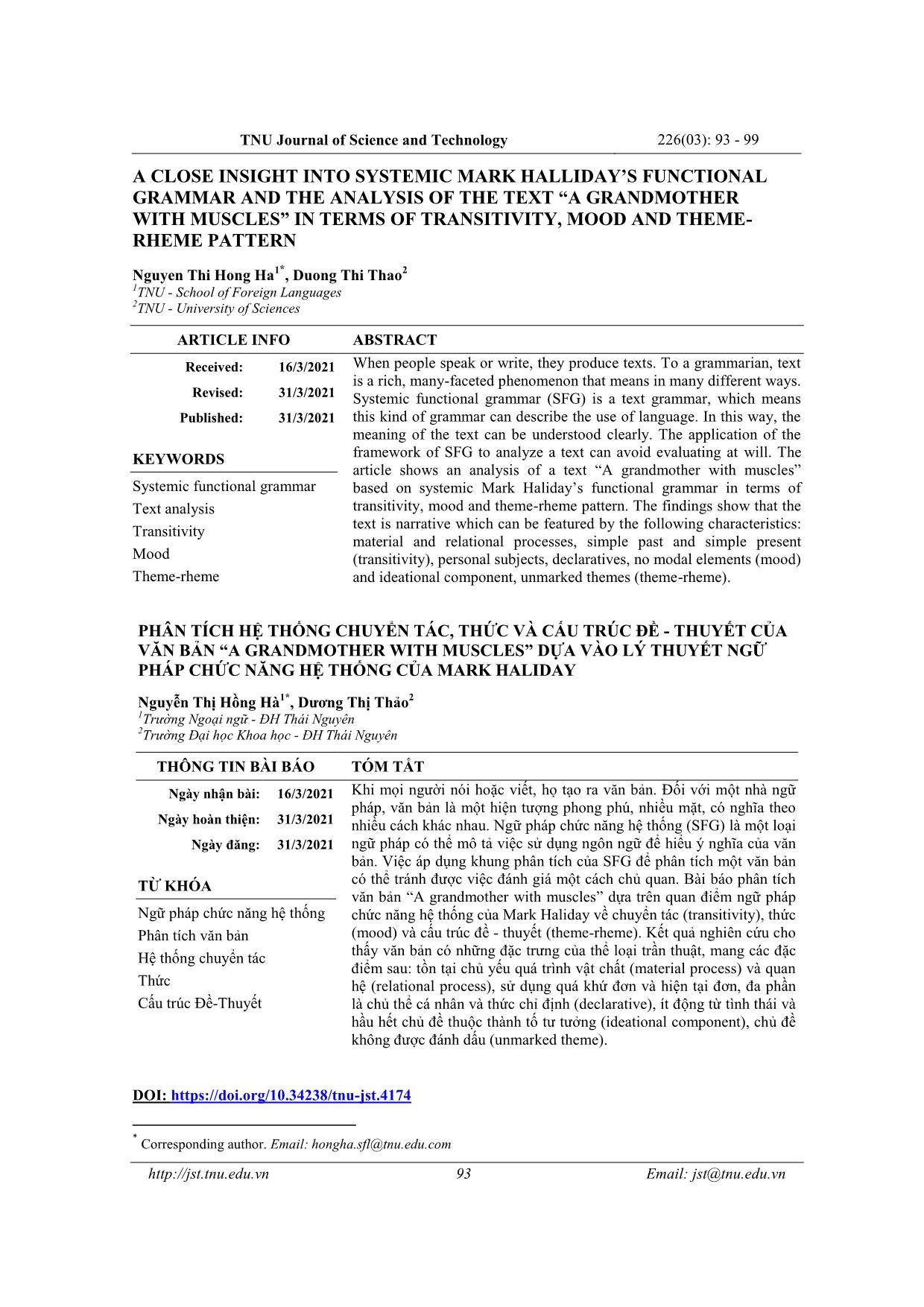
Trang 1
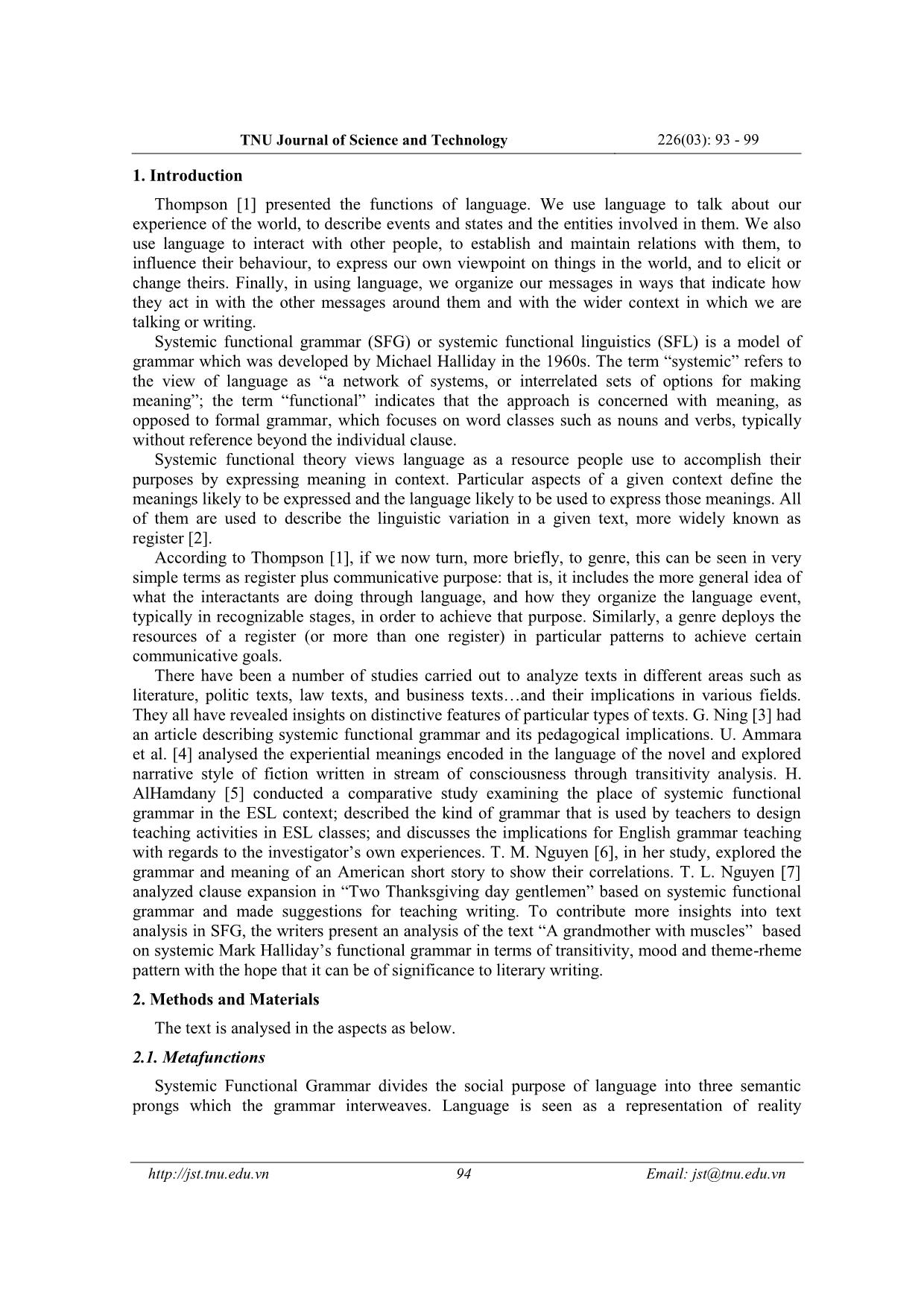
Trang 2
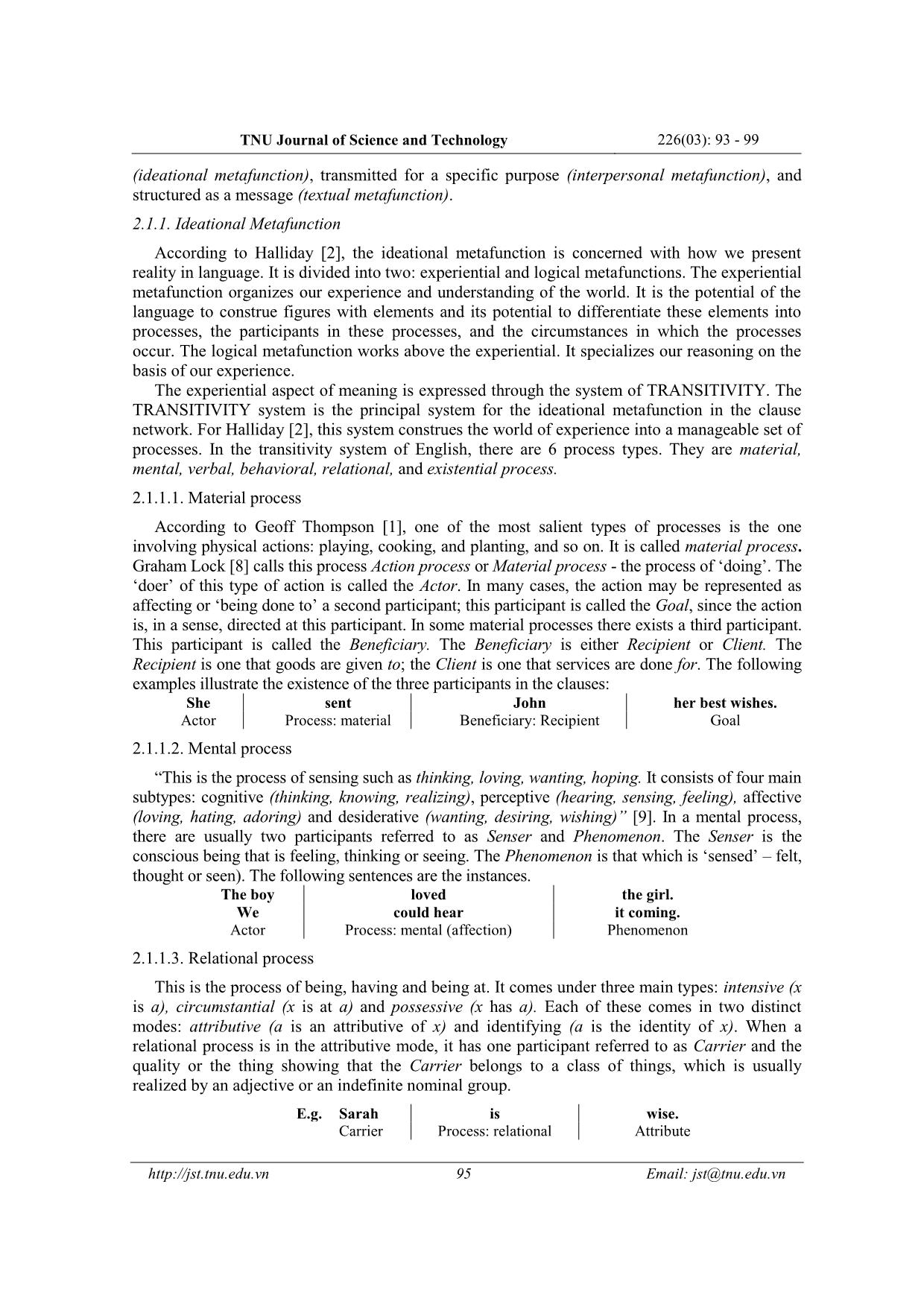
Trang 3
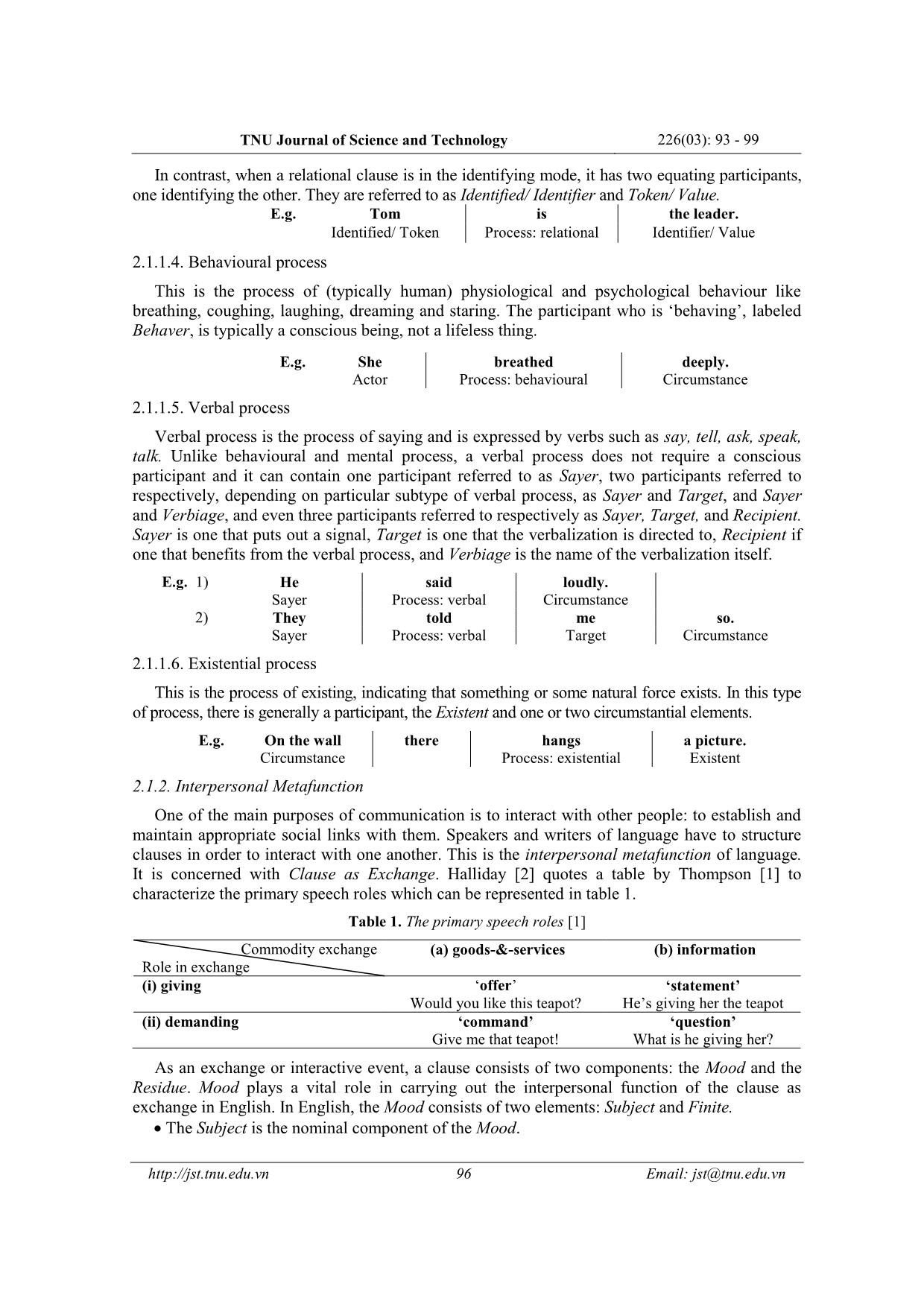
Trang 4
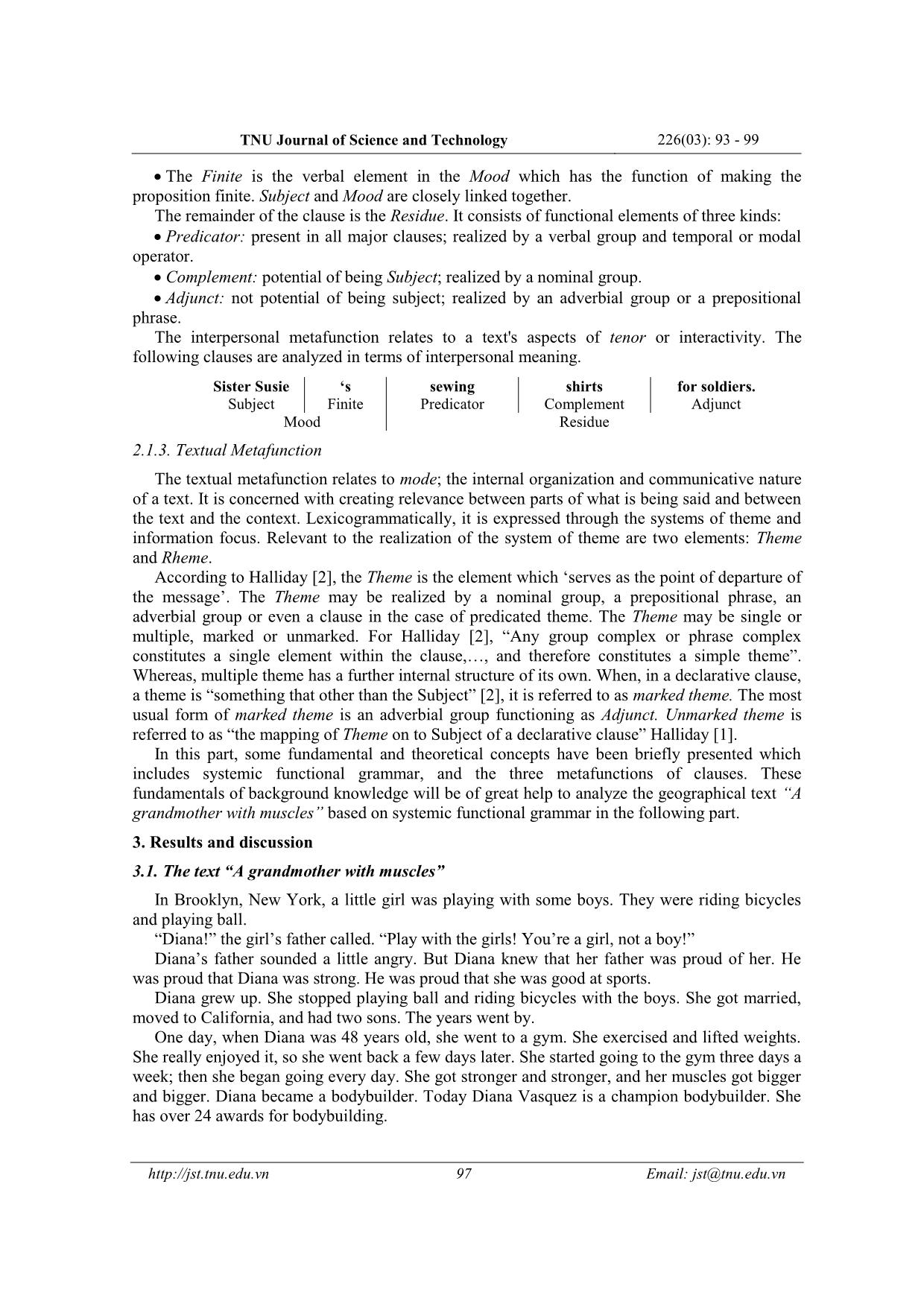
Trang 5
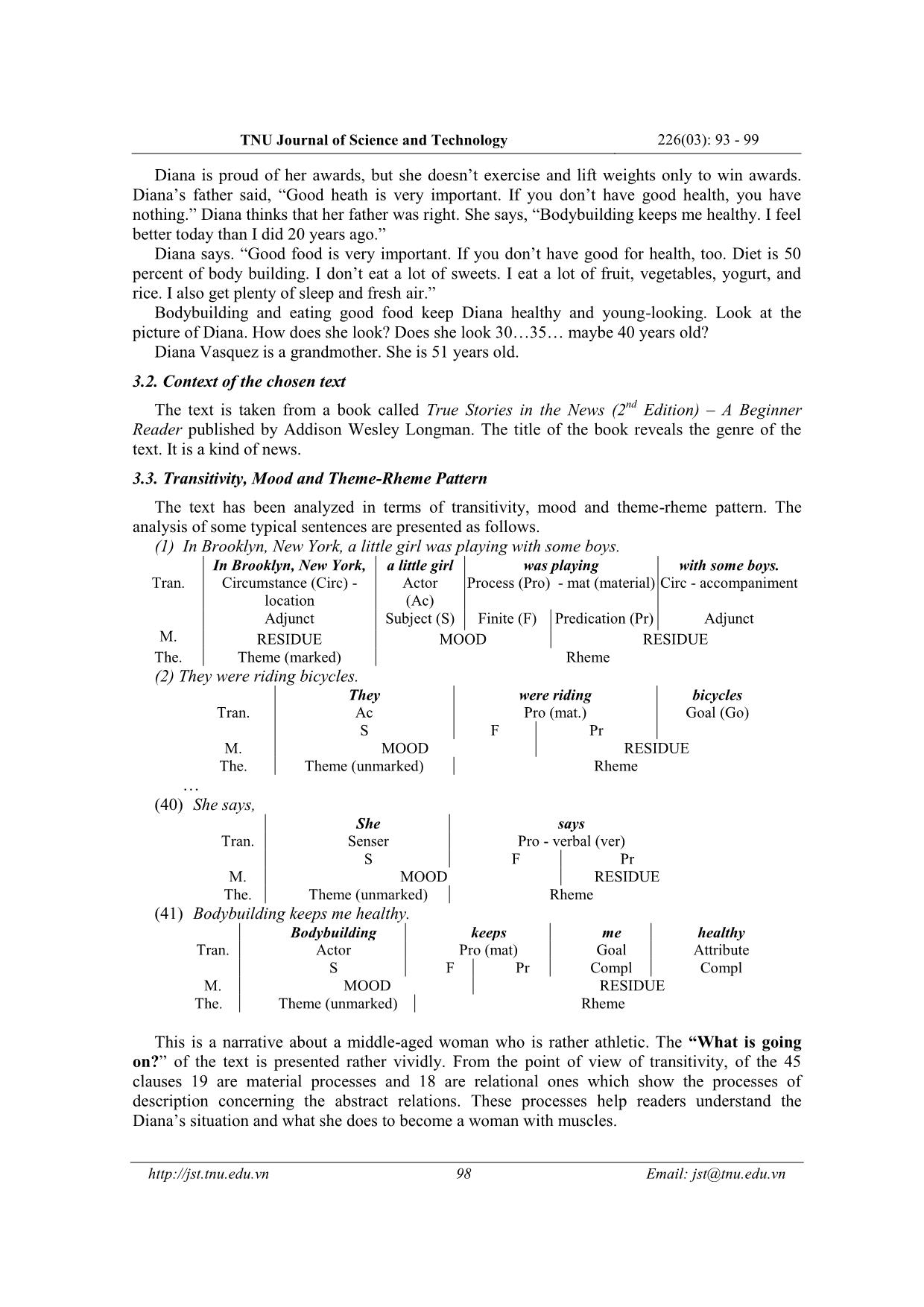
Trang 6
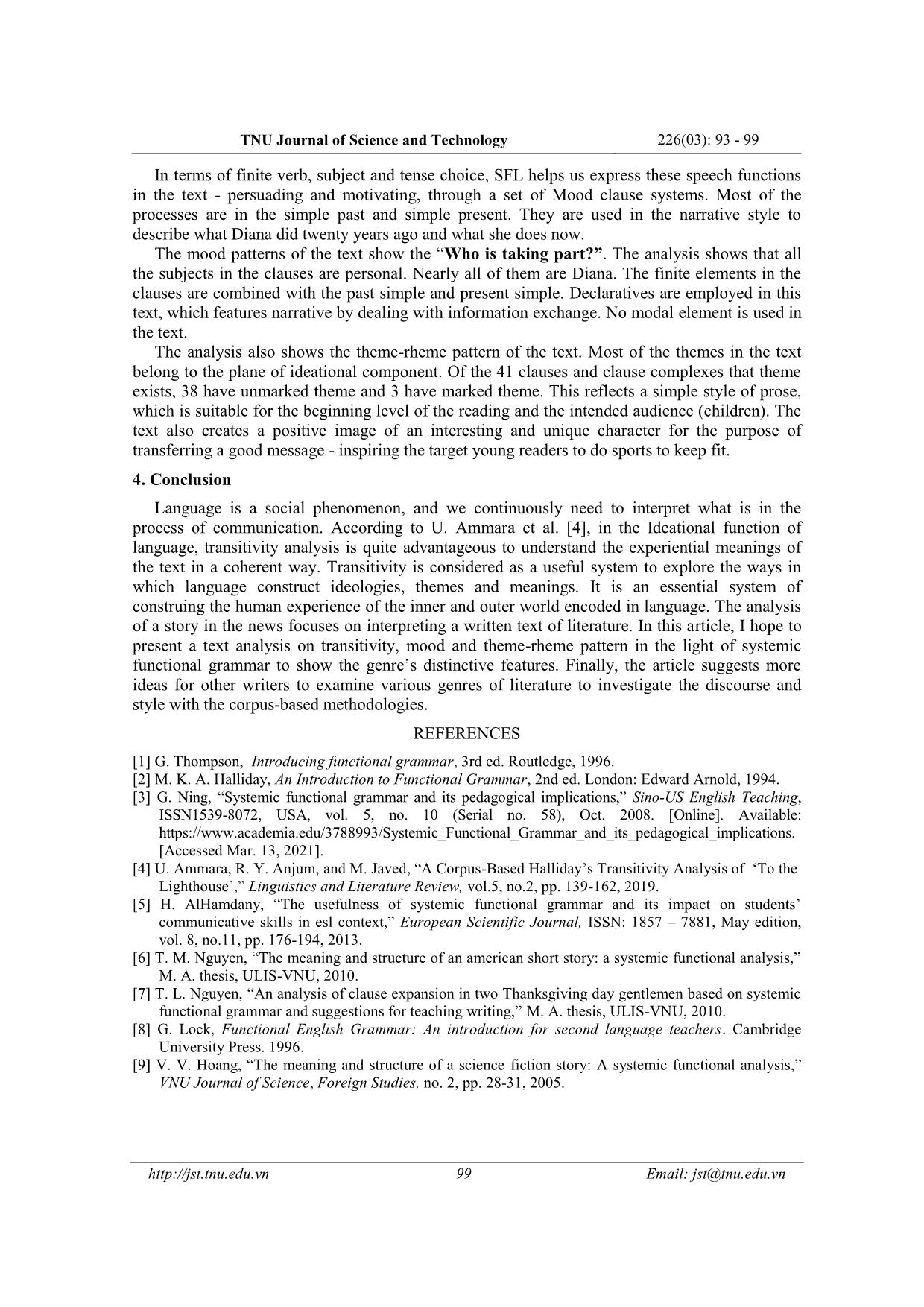
Trang 7
Tóm tắt nội dung tài liệu: Phân tích hệ thống chuyển tác, thức và cấu trúc đề - Thuyết của văn bản “A grandmother with muscles” dựa vào lý thuyết ngữ pháp chức năng hệ thống của mark haliday
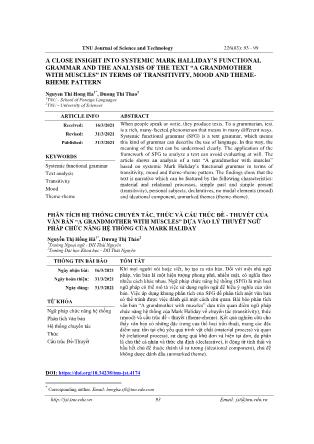
TNU Journal of Science and Technology 226(03): 93 - 99 93 Email: jst@tnu.edu.vn A CLOSE INSIGHT INTO SYSTEMIC MARK HALLIDAY‟S FUNCTIONAL GRAMMAR AND THE ANALYSIS OF THE TEXT “A GRANDMOTHER WITH MUSCLES” IN TERMS OF TRANSITIVITY, MOOD AND THEME- RHEME PATTERN Nguyen Thi Hong Ha 1* , Duong Thi Thao 2 1TNU - School of Foreign Languages 2TNU - University of Sciences ARTICLE INFO ABSTRACT Received: 16/3/2021 When people speak or write, they produce texts. To a grammarian, text is a rich, many-faceted phenomenon that means in many different ways. Systemic functional grammar (SFG) is a text grammar, which means this kind of grammar can describe the use of language. In this way, the meaning of the text can be understood clearly. The application of the framework of SFG to analyze a text can avoid evaluating at will. The article shows an analysis of a text “A grandmother with muscles” based on systemic Mark Haliday‟s functional grammar in terms of transitivity, mood and theme-rheme pattern. The findings show that the text is narrative which can be featured by the following characteristics: material and relational processes, simple past and simple present (transitivity), personal subjects, declaratives, no modal elements (mood) and ideational component, unmarked themes (theme-rheme). Revised: 31/3/2021 Published: 31/3/2021 KEYWORDS Systemic functional grammar Text analysis Transitivity Mood Theme-rheme PHÂN TÍCH HỆ THỐNG CHUYỂN TÁC, THỨC VÀ CẤU TRÚC ĐỀ - THUYẾT CỦA VĂN BẢN “A GRANDMOTHER WITH MUSCLES” DỰA VÀO LÝ THUYẾT NGỮ PHÁP CHỨC NĂNG HỆ THỐNG CỦA MARK HALIDAY Nguyễn Thị Hồng Hà1*, Dương Thị Thảo2 1Trường Ngoại ngữ - ĐH Thái Nguyên 2Trường Đại học Khoa học - ĐH Thái Nguyên THÔNG TIN BÀI BÁO TÓM TẮT Ngày nhận bài: 16/3/2021 Khi mọi người nói hoặc viết, họ tạo ra văn bản. Đối với một nhà ngữ pháp, văn bản là một hiện tượng phong phú, nhiều mặt, có nghĩa theo nhiều cách khác nhau. Ngữ pháp chức năng hệ thống (SFG) là một loại ngữ pháp có thể mô tả việc sử dụng ngôn ngữ để hiểu ý nghĩa của văn bản. Việc áp dụng khung phân tích của SFG để phân tích một văn bản có thể tránh được việc đánh giá một cách chủ quan. Bài báo phân tích văn bản “A grandmother with muscles” dựa trên quan điểm ngữ pháp chức năng hệ thống của Mark Haliday về chuyển tác (transitivity), thức (mood) và cấu trúc đề - thuyết (theme-rheme). Kết quả nghiên cứu cho thấy văn bản có những đặc trưng của thể loại trần thuật, mang các đặc điểm sau: tồn tại chủ yếu quá trình vật chất (material process) và quan hệ (relational process), sử dụng quá khứ đơn và hiện tại đơn, đa phần là chủ thể cá nhân và thức chỉ định (declarative), ít động từ tình thái và hầu hết chủ đề thuộc thành tố tư tưởng (ideational component), chủ đề không được đánh dấu (unmarked theme). Ngày hoàn thiện: 31/3/2021 Ngày đăng: 31/3/2021 TỪ KHÓA Ngữ pháp chức năng hệ thống Phân tích văn bản Hệ thống chuyển tác Thức Cấu trúc Đề-Thuyết DOI: https://doi.org/10.34238/tnu-jst.4174 * Corresponding author. Email: hongha.sfl@tnu.edu.com TNU Journal of Science and Technology 226(03): 93 - 99 94 Email: jst@tnu.edu.vn 1. Introduction Thompson [1] presented the functions of language. We use language to talk about our experience of the world, to describe events and states and the entities involved in them. We also use language to interact with other people, to establish and maintain relations with them, to influence their behaviour, to express our own viewpoint on things in the world, and to elicit or change theirs. Finally, in using language, we organize our messages in ways that indicate how they act in with the other messages around them and with the wider context in which we are talking or writing. Systemic functional grammar (SFG) or systemic functional linguistics (SFL) is a model of grammar which was developed by Michael Halliday in the 1960s. The term “systemic” refers to the view of language as “a network of systems, or interrelated sets of options for making meaning”; the term “functional” indicates that the approach is concerned with meaning, as opposed to formal grammar, which focuses on word classes such as nouns and verbs, typically without reference beyond the individual clause. Systemic functional theory views language as a resource people use to accomplish their purposes by expressing meaning in context. Particular aspects of a given context define the meanings likely to be expressed and the language likely to be used to express those meanings. All of them are used to describe the linguistic variation in a given text, more widely known as register [2]. According to Thompson [1], if we now turn, more briefly, to genre, this can be seen in very simple terms as register plus communicative purpose: that is, it includes the more general idea of what the interactants are doing through language, and how they organize the language event, typically in recognizable stages, in order to achieve that purpose. Similarly, a genre deploys the resources of a register (or more than one register) in particular patterns to achieve certain communicative goals. There have been a number of studies carried out to analyze texts in different areas such as literature, politic texts, law texts, and business textsand their implications in various fields. They all have revealed insights on distinctive features of particular types of texts. G. Ning [3] had an article describing systemic functional grammar and its pedagogical implications. U. Ammara et al. [4] analysed the experiential meanings encoded in the language of the novel and explored narrative style of fiction written in stream of consciousness through transitivity analysis. H. AlHamdany [5] conducted a comparative study examining the place of systemic functional grammar in the ESL context; described the kind of grammar that is used by teachers t ... – felt, thought or seen). The following sentences are the instances. The boy loved the girl. We could hear it coming. Actor Process: mental (affection) Phenomenon 2.1.1.3. Relational process This is the process of being, having and being at. It comes under three main types: intensive (x is a), circumstantial (x is at a) and possessive (x has a). Each of these comes in two distinct modes: attributive (a is an attributive of x) and identifying (a is the identity of x). When a relational process is in the attributive mode, it has one participant referred to as Carrier and the quality or the thing showing that the Carrier belongs to a class of things, which is usually realized by an adjective or an indefinite nominal group. E.g. Sarah is wise. Carrier Process: relational Attribute TNU Journal of Science and Technology 226(03): 93 - 99 96 Email: jst@tnu.edu.vn In contrast, when a relational clause is in the identifying mode, it has two equating participants, one identifying the other. They are referred to as Identified/ Identifier and Token/ Value. E.g. Tom is the leader. Identified/ Token Process: relational Identifier/ Value 2.1.1.4. Behavioural process This is the process of (typically human) physiological and psychological behaviour like breathing, coughing, laughing, dreaming and staring. The participant who is „behaving‟, labeled Behaver, is typically a conscious being, not a lifeless thing. E.g. She breathed deeply. Actor Process: behavioural Circumstance 2.1.1.5. Verbal process Verbal process is the process of saying and is expressed by verbs such as say, tell, ask, speak, talk. Unlike behavioural and mental process, a verbal process does not require a conscious participant and it can contain one participant referred to as Sayer, two participants referred to respectively, depending on particular subtype of verbal process, as Sayer and Target, and Sayer and Verbiage, and even three participants referred to respectively as Sayer, Target, and Recipient. Sayer is one that puts out a signal, Target is one that the verbalization is directed to, Recipient if one that benefits from the verbal process, and Verbiage is the name of the verbalization itself. E.g. 1) He said loudly. Sayer Process: verbal Circumstance 2) They told me so. Sayer Process: verbal Target Circumstance 2.1.1.6. Existential process This is the process of existing, indicating that something or some natural force exists. In this type of process, there is generally a participant, the Existent and one or two circumstantial elements. E.g. On the wall there hangs a picture. Circumstance Process: existential Existent 2.1.2. Interpersonal Metafunction One of the main purposes of communication is to interact with other people: to establish and maintain appropriate social links with them. Speakers and writers of language have to structure clauses in order to interact with one another. This is the interpersonal metafunction of language. It is concerned with Clause as Exchange. Halliday [2] quotes a table by Thompson [1] to characterize the primary speech roles which can be represented in table 1. Table 1. The primary speech roles [1] Commodity exchange Role in exchange (a) goods-&-services (b) information (i) giving „offer‟ Would you like this teapot? „statement‟ He‟s giving her the teapot (ii) demanding „command‟ Give me that teapot! „question‟ What is he giving her? As an exchange or interactive event, a clause consists of two components: the Mood and the Residue. Mood plays a vital role in carrying out the interpersonal function of the clause as exchange in English. In English, the Mood consists of two elements: Subject and Finite. The Subject is the nominal component of the Mood. TNU Journal of Science and Technology 226(03): 93 - 99 97 Email: jst@tnu.edu.vn The Finite is the verbal element in the Mood which has the function of making the proposition finite. Subject and Mood are closely linked together. The remainder of the clause is the Residue. It consists of functional elements of three kinds: Predicator: present in all major clauses; realized by a verbal group and temporal or modal operator. Complement: potential of being Subject; realized by a nominal group. Adjunct: not potential of being subject; realized by an adverbial group or a prepositional phrase. The interpersonal metafunction relates to a text's aspects of tenor or interactivity. The following clauses are analyzed in terms of interpersonal meaning. Sister Susie „s sewing shirts for soldiers. Subject Finite Predicator Complement Adjunct Mood Residue 2.1.3. Textual Metafunction The textual metafunction relates to mode; the internal organization and communicative nature of a text. It is concerned with creating relevance between parts of what is being said and between the text and the context. Lexicogrammatically, it is expressed through the systems of theme and information focus. Relevant to the realization of the system of theme are two elements: Theme and Rheme. According to Halliday [2], the Theme is the element which „serves as the point of departure of the message‟. The Theme may be realized by a nominal group, a prepositional phrase, an adverbial group or even a clause in the case of predicated theme. The Theme may be single or multiple, marked or unmarked. For Halliday [2], “Any group complex or phrase complex constitutes a single element within the clause,, and therefore constitutes a simple theme”. Whereas, multiple theme has a further internal structure of its own. When, in a declarative clause, a theme is “something that other than the Subject” [2], it is referred to as marked theme. The most usual form of marked theme is an adverbial group functioning as Adjunct. Unmarked theme is referred to as “the mapping of Theme on to Subject of a declarative clause” Halliday [1]. In this part, some fundamental and theoretical concepts have been briefly presented which includes systemic functional grammar, and the three metafunctions of clauses. These fundamentals of background knowledge will be of great help to analyze the geographical text “A grandmother with muscles” based on systemic functional grammar in the following part. 3. Results and discussion 3.1. The text “A grandmother with muscles” In Brooklyn, New York, a little girl was playing with some boys. They were riding bicycles and playing ball. “Diana!” the girl‟s father called. “Play with the girls! You‟re a girl, not a boy!” Diana‟s father sounded a little angry. But Diana knew that her father was proud of her. He was proud that Diana was strong. He was proud that she was good at sports. Diana grew up. She stopped playing ball and riding bicycles with the boys. She got married, moved to California, and had two sons. The years went by. One day, when Diana was 48 years old, she went to a gym. She exercised and lifted weights. She really enjoyed it, so she went back a few days later. She started going to the gym three days a week; then she began going every day. She got stronger and stronger, and her muscles got bigger and bigger. Diana became a bodybuilder. Today Diana Vasquez is a champion bodybuilder. She has over 24 awards for bodybuilding. TNU Journal of Science and Technology 226(03): 93 - 99 98 Email: jst@tnu.edu.vn Diana is proud of her awards, but she doesn‟t exercise and lift weights only to win awards. Diana‟s father said, “Good heath is very important. If you don‟t have good health, you have nothing.” Diana thinks that her father was right. She says, “Bodybuilding keeps me healthy. I feel better today than I did 20 years ago.” Diana says. “Good food is very important. If you don‟t have good for health, too. Diet is 50 percent of body building. I don‟t eat a lot of sweets. I eat a lot of fruit, vegetables, yogurt, and rice. I also get plenty of sleep and fresh air.” Bodybuilding and eating good food keep Diana healthy and young-looking. Look at the picture of Diana. How does she look? Does she look 3035 maybe 40 years old? Diana Vasquez is a grandmother. She is 51 years old. 3.2. Context of the chosen text The text is taken from a book called True Stories in the News (2 nd Edition) – A Beginner Reader published by Addison Wesley Longman. The title of the book reveals the genre of the text. It is a kind of news. 3.3. Transitivity, Mood and Theme-Rheme Pattern The text has been analyzed in terms of transitivity, mood and theme-rheme pattern. The analysis of some typical sentences are presented as follows. (1) In Brooklyn, New York, a little girl was playing with some boys. In Brooklyn, New York, a little girl was playing with some boys. Tran. Circumstance (Circ) - location Actor (Ac) Process (Pro) - mat (material) Circ - accompaniment M. Adjunct Subject (S) Finite (F) Predication (Pr) Adjunct RESIDUE MOOD RESIDUE The. Theme (marked) Rheme (2) They were riding bicycles. They were riding bicycles Tran. Ac Pro (mat.) Goal (Go) M. S F Pr MOOD RESIDUE The. Theme (unmarked) Rheme (40) She says, She says Tran. Senser Pro - verbal (ver) M. S F Pr MOOD RESIDUE The. Theme (unmarked) Rheme (41) Bodybuilding keeps me healthy. Bodybuilding keeps me healthy Tran. Actor Pro (mat) Goal Attribute M. S F Pr Compl Compl MOOD RESIDUE The. Theme (unmarked) Rheme This is a narrative about a middle-aged woman who is rather athletic. The “What is going on?” of the text is presented rather vividly. From the point of view of transitivity, of the 45 clauses 19 are material processes and 18 are relational ones which show the processes of description concerning the abstract relations. These processes help readers understand the Diana‟s situation and what she does to become a woman with muscles. TNU Journal of Science and Technology 226(03): 93 - 99 99 Email: jst@tnu.edu.vn In terms of finite verb, subject and tense choice, SFL helps us express these speech functions in the text - persuading and motivating, through a set of Mood clause systems. Most of the processes are in the simple past and simple present. They are used in the narrative style to describe what Diana did twenty years ago and what she does now. The mood patterns of the text show the “Who is taking part?”. The analysis shows that all the subjects in the clauses are personal. Nearly all of them are Diana. The finite elements in the clauses are combined with the past simple and present simple. Declaratives are employed in this text, which features narrative by dealing with information exchange. No modal element is used in the text. The analysis also shows the theme-rheme pattern of the text. Most of the themes in the text belong to the plane of ideational component. Of the 41 clauses and clause complexes that theme exists, 38 have unmarked theme and 3 have marked theme. This reflects a simple style of prose, which is suitable for the beginning level of the reading and the intended audience (children). The text also creates a positive image of an interesting and unique character for the purpose of transferring a good message - inspiring the target young readers to do sports to keep fit. 4. Conclusion Language is a social phenomenon, and we continuously need to interpret what is in the process of communication. According to U. Ammara et al. [4], in the Ideational function of language, transitivity analysis is quite advantageous to understand the experiential meanings of the text in a coherent way. Transitivity is considered as a useful system to explore the ways in which language construct ideologies, themes and meanings. It is an essential system of construing the human experience of the inner and outer world encoded in language. The analysis of a story in the news focuses on interpreting a written text of literature. In this article, I hope to present a text analysis on transitivity, mood and theme-rheme pattern in the light of systemic functional grammar to show the genre‟s distinctive features. Finally, the article suggests more ideas for other writers to examine various genres of literature to investigate the discourse and style with the corpus-based methodologies. REFERENCES [1] G. Thompson, Introducing functional grammar, 3rd ed. Routledge, 1996. [2] M. K. A. Halliday, An Introduction to Functional Grammar, 2nd ed. London: Edward Arnold, 1994. [3] G. Ning, “Systemic functional grammar and its pedagogical implications,” Sino-US English Teaching, ISSN1539-8072, USA, vol. 5, no. 10 (Serial no. 58), Oct. 2008. [Online]. Available: https://www.academia.edu/3788993/Systemic_Functional_Grammar_and_its_pedagogical_implications. [Accessed Mar. 13, 2021]. [4] U. Ammara, R. Y. Anjum, and M. Javed, “A Corpus-Based Halliday‟s Transitivity Analysis of „To the Lighthouse‟,” Linguistics and Literature Review, vol.5, no.2, pp. 139-162, 2019. [5] H. AlHamdany, “The usefulness of systemic functional grammar and its impact on students‟ communicative skills in esl context,” European Scientific Journal, ISSN: 1857 – 7881, May edition, vol. 8, no.11, pp. 176-194, 2013. [6] T. M. Nguyen, “The meaning and structure of an american short story: a systemic functional analysis,” M. A. thesis, ULIS-VNU, 2010. [7] T. L. Nguyen, “An analysis of clause expansion in two Thanksgiving day gentlemen based on systemic functional grammar and suggestions for teaching writing,” M. A. thesis, ULIS-VNU, 2010. [8] G. Lock, Functional English Grammar: An introduction for second language teachers. Cambridge University Press. 1996. [9] V. V. Hoang, “The meaning and structure of a science fiction story: A systemic functional analysis,” VNU Journal of Science, Foreign Studies, no. 2, pp. 28-31, 2005.
File đính kèm:
 phan_tich_he_thong_chuyen_tac_thuc_va_cau_truc_de_thuyet_cua.pdf
phan_tich_he_thong_chuyen_tac_thuc_va_cau_truc_de_thuyet_cua.pdf

